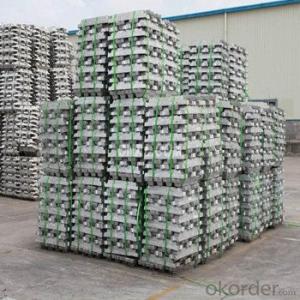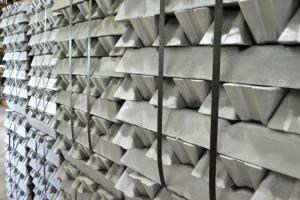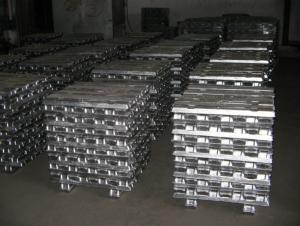Aluminum Ingots AA3005
- Loading Port:
- Shanghai
- Payment Terms:
- TT or LC
- Min Order Qty:
- 20 Tons m.t.
- Supply Capability:
- 1000 Sets Per Month m.t./month
OKorder Service Pledge
OKorder Financial Service
You Might Also Like
1. Specifications of Aluminum Ingots AA3005
Product Name | Aluminum Ingot |
Chemical Composition | Al |
Weight | 20/25kg |
Al (Min) | 99%-99.9% |
Appearance | silvery white |
Advantages | easy control and operation, fast melting |
Chemical composition of Aluminum Ingots AA3005
Grade | Chemical Composition % | |||||||||
Al≥ | Si | Fe | Cu | Ga | Mg | Zn | Mn | others | Sum | |
Al99.9 | 99.90 | 0.50 | 0.07 | 0.005 | 0.02 | 0.01 | 0.025 | - | 0.010 | 0.10 |
Al99.85 | 99.85 | 0.80 | 0.12 | 0.005 | 0.03 | 0.02 | 0.030 | - | 0.015 | 0.15 |
Al99.7 | 99.70 | 0.10 | 0.20 | 0.010 | 0.03 | 0.02 | 0.030 | - | 0.030 | 0.30 |
Al99.6 | 99.60 | 0.16 | 0.25 | 0.010 | 0.03 | 0.03 | 0.030 | - | 0.030 | 0.40 |
Al99.5 | 99.50 | 0.22 | 0.30 | 0.020 | 0.03 | 0.05 | 0.050 | - | 0.030 | 0.50 |
Al99.00 | 99.00 | 0.42 | 0.50 | 0.020 | 0.03 | 0.05 | 0.050 | - | 0.050 | 1.00 |

2. Usage/Application of Aluminum Ingots AA3005
1. mainly used for melting ingot
2. discontinuous melting with scrap
3. easy control and operation
4. fast melting
5. Used for industry such as automobile,pinning and weaving,electron broadly and so on
3.Packaging & Delivery of Aluminum Ingots AA3003
About 25Kg /Ingot, Packed in wooden case, Net weight 1000Kg/ Case, or as customer's requirements.
- Q: Can aluminum ingots be customized for specific applications?
- Certainly, specific applications can have customized aluminum ingots. Aluminum, a remarkably adaptable metal, can be effortlessly shaped to fulfill diverse needs. Typically, the customization procedure includes combining the aluminum with other elements to amplify qualities like strength, hardness, resistance to corrosion, and thermal conductivity. Furthermore, the ingots can undergo various heat treatment methods such as annealing, quenching, and tempering to further adjust their properties. Consequently, aluminum ingots that are precisely designed for particular applications can be manufactured, encompassing a wide range from automotive parts and aerospace components to construction materials and consumer products.
- Q: What's the difference between aluminium ingot A380 and ADC12?
- ADC12 material has better flowability than A380, and silicon content is higher than A380. But the mechanical properties of the two materials can be universal. Two types of materials can be mixed, it is recommended to communicate with customers first
- Q: How to refine aluminum ingot
- As for the procedures, just started, can not do not do, not encourage illegal business, but then you should make the cash flow on the blade, so you have to consider your experience to set up the factory scale, and then targeted the related formalities, in fact you know some of the company law and policy development and Reform Commission, there will be a natural answer. Your own understanding of the industry is the most important.
- Q: How can the aluminum factory calculate the cost better?
- The cost includes aluminum ingot and processing costs (casting, extrusion, surface treatment) processing costs, including 1. manufacturing costs, various tools, equipment fittings, tooling, labor protection. 1, wages. 3, equipment depreciation. 4, water, electricity, coal, gas costs. 5, raw and auxiliary materials: packaging paper, film, powder, insulation strip, etc..
- Q: What are the basic equipments for the production of aluminium ingots?
- If you want to match the very homogeneous ingot aluminum melting furnace, automatic machine, automatic folding spindle machine, environmental protection equipment, forklift, spectrum analyzer, loadometer, refining machine etc..
- Q: How are aluminum ingots used in the production of bicycles?
- Aluminum ingots are used in the production of bicycles as they are melted down and shaped into various bike components, including frames, handlebars, and rims. The lightweight but strong nature of aluminum makes it an ideal material for constructing bicycles, ensuring durability and enhancing performance.
- Q: How are impurities removed from aluminum ingots?
- The elimination of impurities from aluminum ingots is achieved through a process called refining or purification. Various methods are utilized for this purpose, which include the following: 1. Fluxing: To react with the impurities, molten aluminum is combined with fluxes like chlorine or sodium chloride. This reaction produces compounds that can be easily eliminated as slag or dross. 2. Electrolytic refining: Impure aluminum ingots are immersed in an electrolyte solution and subjected to an electric current in this technique. The impurities are drawn towards the anode, where they accumulate as a residue, while the purified aluminum collects at the cathode. 3. Centrifugal separation: Molten aluminum is spun in a centrifuge, causing the denser impurities to migrate towards the outer edge. The purified aluminum is then collected from the center. 4. Filtration: Solid impurities in the molten aluminum can be eliminated through filtration. Filters made of materials like ceramic or graphite are used, which trap the impurities while allowing the purified aluminum to pass through. 5. Vacuum treatment: Molten aluminum undergoes a vacuum environment in this method, aiding in the removal of volatile impurities such as hydrogen and low-boiling-point metals. The reduced pressure facilitates the removal of these impurities through vaporization. It is crucial to consider various factors, such as the type and concentration of impurities, the desired level of purity, and the cost-effectiveness of the chosen process, when selecting a specific method for impurity removal. Different industries and applications may require different levels of purity, thus leading to variations in the refining process.
- Q: What is the difference between aluminium ingot YL112 and YLD112?
- YL102 is the only major alloy element that can be cast. It is a silicon second aluminum alloy with a silicon content of 10.0~13.0%,
- Q: Who knows, general aluminium ingot has those specifications?
- The aluminum ingot is divided into three kinds: aluminium ingots, high-purity aluminium ingots and aluminium alloy ingots according to different components. They can be divided into strips, round ingots, plate ingots, T ingots and so on according to shape and size.
- Q: It can be dissolved aluminum cans, aluminum ingots, need what equipment?
- The feasibility is small, impurities are difficult to control, and purity is difficult to reach 99.7%Ingot casting machine.
1. Manufacturer Overview
| Location | Henan,China |
| Year Established | 1993 |
| Annual Output Value | Above US$200 Million |
| Main Markets | Mid East;Eastern Europe;North America |
| Company Certifications | ISO 9001:2000;ISO 14001:2004;OHSAS 18001 |
2. Manufacturer Certificates
| a) Certification Name | |
| Range | |
| Reference | |
| Validity Period |
3. Manufacturer Capability
| a) Trade Capacity | |
| Nearest Port | Shanghai |
| Export Percentage | 30%-50% |
| No.of Employees in Trade Department | 21-50 People |
| Language Spoken: | English;Chinese |
| b) Factory Information | |
| Factory Size: | Above 100,000 square meters |
| No. of Production Lines | Above 10 |
| Contract Manufacturing | OEM Service Offered;Design Service Offered |
| Product Price Range | Average |
Send your message to us
Aluminum Ingots AA3005
- Loading Port:
- Shanghai
- Payment Terms:
- TT or LC
- Min Order Qty:
- 20 Tons m.t.
- Supply Capability:
- 1000 Sets Per Month m.t./month
OKorder Service Pledge
OKorder Financial Service
Similar products
Hot products
Hot Searches
Related keywords



























